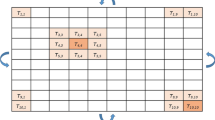Abstract
Cellular genetic algorithms (cGAs) are a kind of genetic algorithms (GAs) with decentralized population in which interactions among individuals are restricted to close ones. The use of decentralized populations in GAs allows to keep the population diversity for longer, usually resulting in a better exploration of the search space and, therefore, in a better performance of the algorithm. However, it supposes the need of several new parameters that have a major impact on the behavior of the algorithm. In the case of cGAs, these parameters are the population and neighborhood shapes. We propose in this work two innovative cGAs with new adaptive techniques that allow removing the neighborhood and population shape from the algorithm’s configuration. As a result, the new adaptive cGAs are highly competitive (statistically) with all the compared cGAs in terms of the average solutions found in the continuous and combinatorial domains, while finding, in general, the best solutions for the considered problems, and with less computational effort.







Similar content being viewed by others
Notes
JCell is available for download at: http://jcell.gforge.uni.lu/.
References
Alba E, Dorronsoro B (2005) The exploration/exploitation tradeoff in dynamic cellular evolutionary algorithms. IEEE Trans Evol Comput 9(2):126–142
Alba E, Dorronsoro B (2008) Cellular genetic algorithms. Operations research/computer science interfaces. Springer, Heidelberg
Alba E, Dorronsoro B, Giacobini M, Tomassini M (2006) Decentralized cellular evolutionary algorithms. In: Handbook of bioinspired algorithms and applications. CRC Press, Boca Raton, pp 103–120
Alba E, Tomassini M (2002) Parallelism and evolutionary algorithms. IEEE Trans Evol Comput 6(5):443–462
Alba E, Troya J (2000) Cellular evolutionary algorithms: evaluating the influence of ratio. In: Parallel problem solving from nature. Springer, Berlin, vol 1917, pp 29–38
Alba E, Troya J (2002) Improving flexibility and efficiency by adding parallelism to genetic algorithms. Soft Comput 12(2):91–114
Bäck T, Fogel D, Michalewicz Z (eds) (1997) Handbook of evolutionary computation. Oxford University Press, London
Deb K, Goyal M (1996) A combined genetic adaptive search (GeneAS) for engineering design. Comput Sci Inform 26(4):30–45
Dorronsoro B, Bouvry P (2011) Adaptive neighborhoods for cellular genetic algorithms. In: Nature inspired distributed computing (NIDISC). IEEE Press, New York, pp 383–389
Eshelman L, Schaffer J (1993) Real coded genetic algorithms and interval schemata. In: Foundations of genetic algorithms (FOGA). Morgan-Kaufmann, San Mateo, pp 187–202
García S, Molina D, Lozano M, Herrera F (2009) A study on the use of non-parametric tests for analyzing the evolutionary algorithms’ behaviour: a case study on the CEC’05 special session on real parameter optimization. J Heuristics 15:617–644
Glover F, Kochenberger G (eds) (2003) Handbook of metaheuristics. International series in operations research management science. Kluwer Academic, Dordrecht
Luque G, Alba E, Dorronsoro B (2009) Optimization techniques for solving complex problems. In: Analyzing parallel cellular genetic algorithms, pp 49–62
Manderick B, Spiessens P (1989) Fine-grained parallel genetic algorithm. In: Third int conf on genetic algorithms ICGA-3. Morgan-Kaufmann, San Mateo, pp 428–433
Olariu S, Zomaya A (eds) (2006) Handbook of bioinspired algorithms and applications. CRC Press, Boca Raton
Pinel F, Dorronsoro B, Bouvry P (2012) Solving very large instances of the scheduling of independent tasks problem on the GPU. J Parallel Distrib Comput. To appear, ISSN 0743-7315
Pinel F, Dorronsoro B, Bouvry P (2010) A new parallel asynchronous cellular genetic algorithm for scheduling in grids. In: Nature insp distr comp, p 206b
Sarma J, De Jong K (1996) An analysis of the effect of the neighborhood size and shape on local selection algorithms. In: Parallel problem solving from nature (PPSN-IV). LNCS, vol 1141. Springer, Berlin, pp 236–244
Whitley D (1993) Cellular genetic algorithms. In: Int conf on genetic algs, p 658
Acknowledgement
This work was completed with the support of Luxembourg FNR GreenIT project (C09/IS/05).
Author information
Authors and Affiliations
Corresponding author
Rights and permissions
About this article
Cite this article
Dorronsoro, B., Bouvry, P. Cellular genetic algorithms without additional parameters. J Supercomput 63, 816–835 (2013). https://doi.org/10.1007/s11227-012-0773-y
Published:
Issue Date:
DOI: https://doi.org/10.1007/s11227-012-0773-y




